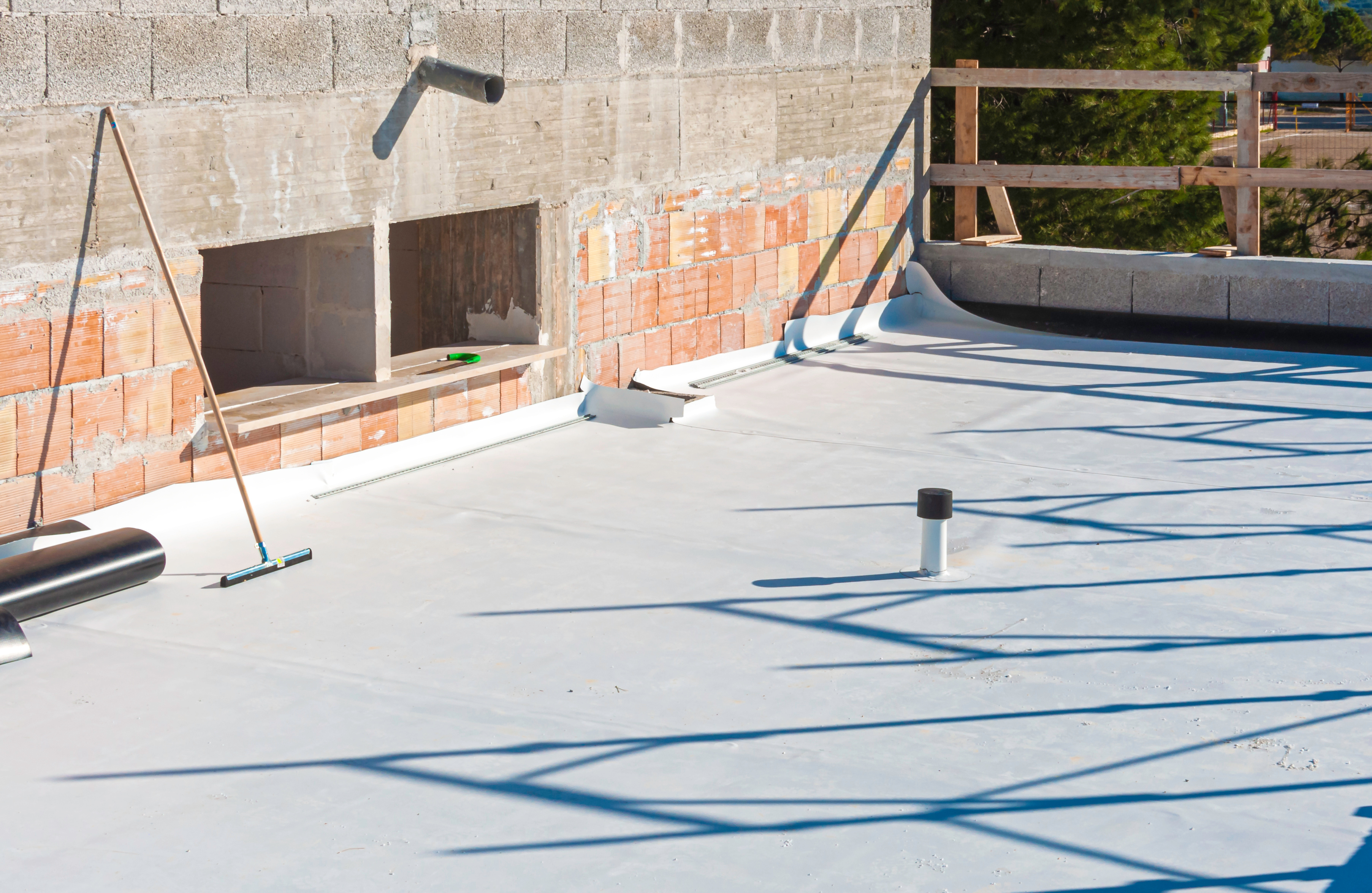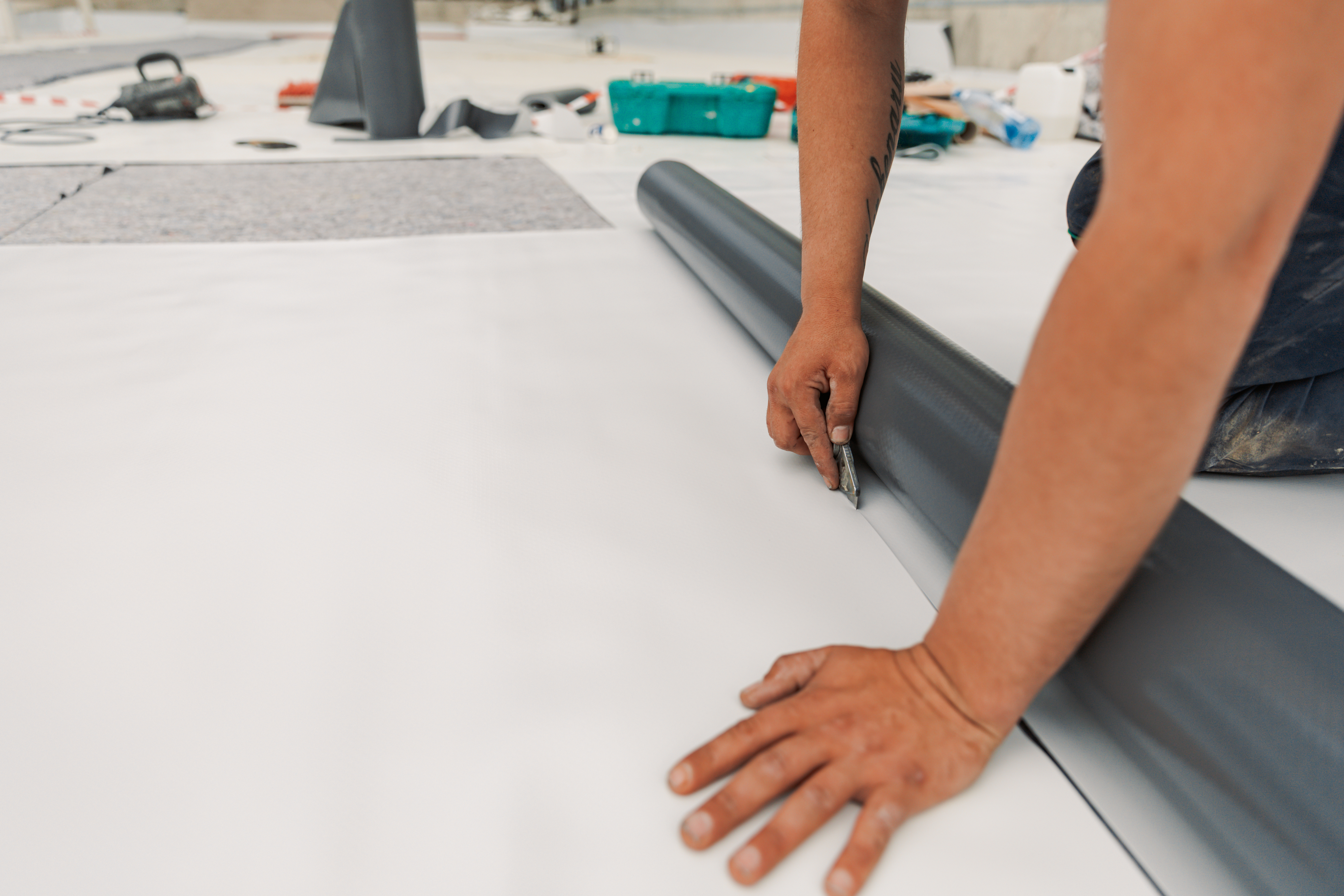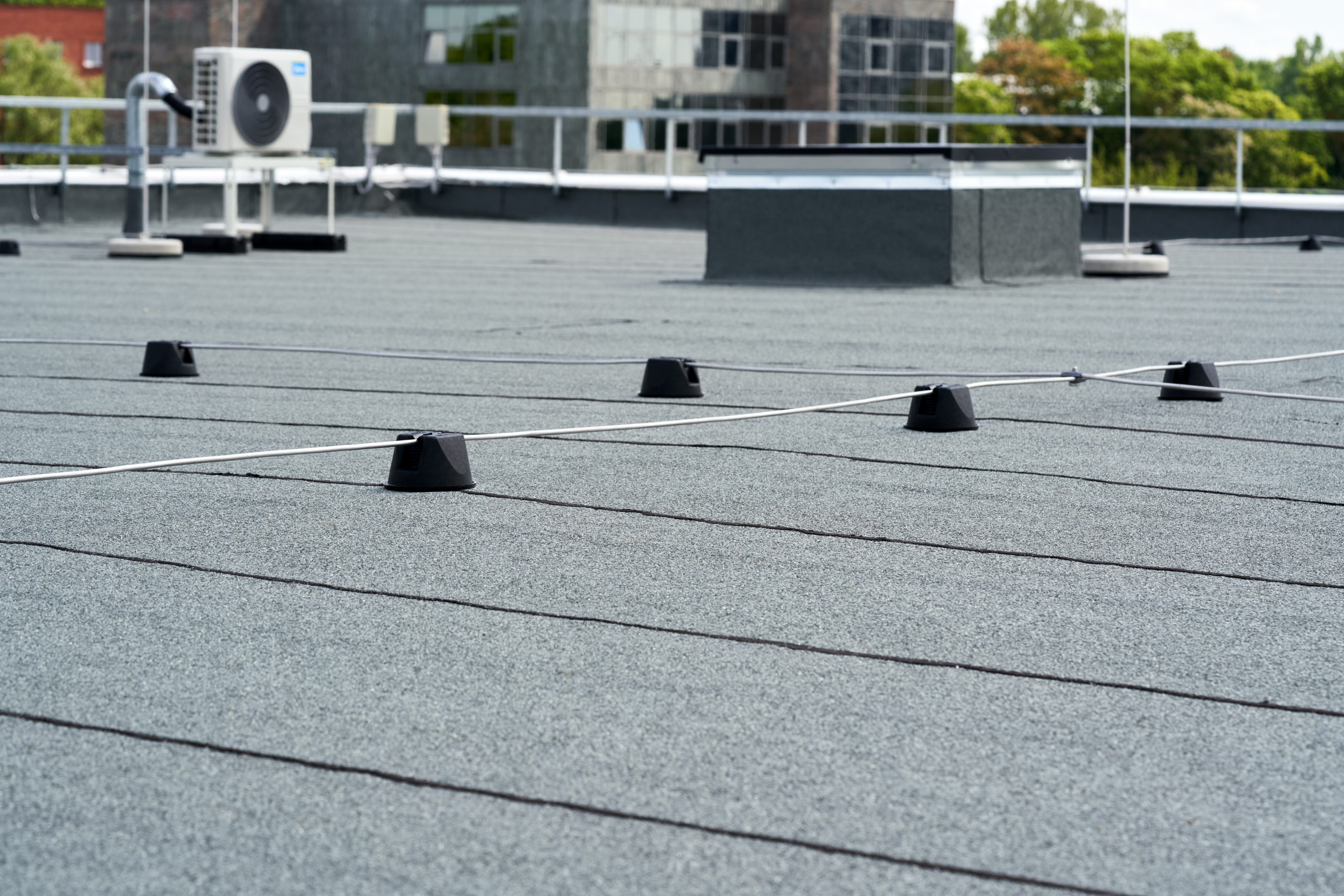Low slope roof options - membrane materials, pitch, and more
When the term low slope roof is used, it's usually in reference to systems with a maximum pitch of 3:12. It is important to note that it's incredibly rare that any roof is truly flat, even "flat roofs" often have slight (hard-to-notice) grades.
Low slope roof advantages
Low slope roofs are a popular option amongst commercial buildings due to their comparative affordability. The minimal pitch cuts down on both the amount of roofing materials and installation hours. Additionally, the design means there is less internal space to heat and cool, further helping building owners save money.As an added bonus, the roof's near flat tops give the option of extra storage and easy access to items, whether that be solar panels, air conditioning units, or cleaning supplies.
Low slope roof disadvantages
The gradual pitch of low slope roofs makes it easier for accumulated snow to stay put and rain to pool, all of which can lead to eventual leaks. This means that building owners will need to stay vigilant in clearing off water and debris. The good news is that it is much easier to do so on low slope roofs compared to steeper options.Teams that will soon construct (or replace) a low slope roof have a number of different options with varying price points, strength levels, and weather resistance. However, most flat roof systems fall into one of two classifications: BUR vs Single Ply Membranes.
Single ply membrane systems as a low slope roof option
Generally speaking, single ply membrane roofing uses a combination of rubber and various chemicals to render protective outer layers with limited seaming. Contractors can choose from a variety of application options; they can lay the materials on top only semi-attached but anchored with the weight of heavy stones (ballasted), or the materials can be fully attached to the board using either chemical-based or mechanical methods.
Polyvinyl chloride (PVC) roofing
Let’s start off with a rising star amongst flat roof systems, PVC roofing. Constructed from thermoplastic materials, it is one of the stronger low slope options. Noteworthy benefits include:
Its default color, white, reflects UV rays rather than absorbing them - This helps keep the building below cooler so it requires less energy utilization. The difference is particularly stark in comparison to black-top EDPM. However, this can cause grime to show more easily.
Durability and longevity - Where PCV differs from the other single ply options is the material’s chemical composition, which is more resistant against fires, chemicals, and UV radiation. As a result, the life expectancy is up to 30 years.
Easy and affordable to maintain - PVC roofs are considered easy to clean with a mild detergent. Maintenance is fairly simple; workers should prevent the build-up of debris (as is true for all flat roof buildings), as well as assess for cracks or ruptures at least once a year.
Recyclability - PVC is a thermoplastic which can ultimately be recycled. Similarly, it uses less energy in its initial production than comparable materials.
With these roofing benefits come higher upfront materials costs. However, given the prolonged expectancy of PVC roofs and ongoing energy savings, this option may help you save money in the long run.

Thermoplastic polyolefin (TPO) roofing
TPO roofing is composed of polypropylene and ethylene-propylene rubber, all of which are amongst the lowest priced material options available to flat roofs.
Expect TPO roofing to last anywhere from 10-25 years (with some estimations being even less). As an overall newer flat roof style, the industry is generally undecided about its durability and level of weather resistance, one of the reasons there’s no agreed-upon lifespan for this membrane roofing material. However, TPO roofing has its upsides as well.
Like PVC, TPO roofing comes in white to reflect away UV rays - In turn, the building naturally spends less money and resources to stay cool in hot summer months.
Affordable upfront costs for materials and labor - This style of flat roofing doesn’t require the same level of expertise as other roofing options, installation times are low, and the system itself is remarkably cheap.
Great resistance to leaks - The welded seams provide lasting leak prevention compared to EPDM’s adhesive- or tape-based seaming.
It’s easy to reseal - This membrane material’s composition returns to a malleable state when reheated, meaning it can be remolded to address cracks and leaks.

EPDM membrane roofing
Ethylene propylene diene terpolymer (EPDM for short) is a synthetic rubber made from oil and natural gas derivatives that form a single-ply membrane. While this membrane type doesn’t match the cost of metal roofing materials and BUR, it can be more expensive than other flat roof options like TPO.
Another key consideration is that EPDM membranes are more susceptible to damage than some other single ply roofing options, especially if it's not fortified. Relatedly, it will require semi-frequent inspections to ensure it hasn’t dangerously shrunk over time. Additionally, the most popular color option, black, will actually absorb heat rather than repel it from the flat roof surface.
So, accounting for elements of this low slope roofing option aside, why is EPDM still worth considering?
First and foremost, EPDM is considered the most affordable of the single ply membrane roofing options, and arguably among the easiest to install. The overall low cost doesn’t necessarily mean a shorter lifespan, as it can last up to 25 years with proper maintenance and upkeep.
This membrane material option is light yet strong, meaning that less stress is placed on the building’s joists. What’s more, when damage occurs, it’s fairly easy to repair with small patches rather than major overhauls. As a bonus, EPDM’s materials can be recycled.

BUR (Built-up roof) membrane systems as a low slope option
This particular low slope roof option consists of asphalt sandwiched between ply sheets or felt alternatives, building on top of one another until capped with a weather-resilient material, like gravel or asphalt.
Though this flat roof technique has been around for centuries, the materials themselves have become more advanced as brands incorporate special properties into the asphalt and ply sheets to better handle dramatic temperature swings. These enhancements are commonly called Modified Bitumen.
While most built-up roofs are sealed with a bitumen-enriched chemical to hold the top layer in place, the Ballasted method uses heavier rocks that remain freeform, counting on their combined mass to secure lower layers.
Benefits of BUR roofing systems include:
Resilient against debris - The multiple layers and durability of the natural materials make it harder to puncture BUR than other flat roof options (like single ply membranes).
Can be easy to repair - All a builder would need to do is replace the damaged element, requiring fewer steps than re-sealing single ply membrane alternatives.
Inherent traction for workers walking on top of the roof - The textured upper layer of a BUR roof will lessen the likelihood of slipping compared to other low slope roof options.
Respectable lifespan - BUR roof systems deliver a decent lifespan of 20-30 years, greater than what’s offered by some of the single ply membrane options we explore below.
High protection against UV rays and fires - The natural materials utilized in BUR flat roofs are inherently resistant to sun and heat, passing along similar protections to the top of the structure.
Potential downsides include:
Could be susceptible to heavy winds - Ballasted rooftop methods run the risk of intense storms and natural disasters blowing the loose top layer from the building, causing damage to gutters or shorter adjacent properties.
Identifying the source of leaks can take time - When single ply membranes leak, it’s most likely due to compromised seaming. Because BUR roofing has no seaming, finding the specific issue requires some detective work.
Mold can grow - Crevices between the gravel or stones can capture moisture that breeds mold, though proper cleaning measures can reduce this risk.
The substantial weight requires extra sturdy structural support - The combined mass of the materials for BUR designs demands a roofing system and building capable of carrying such heaviness for decades.
Support your next low slope build with fasteners from SFS
Regardless of which low slope roofing system you choose, you won’t get the desired results if it's improperly installed. With this in mind, give your contractors the best chance for success with specialized fasteners from world-trusted SFS.
Check out the many low slope roof fastener options we provide, including those designed for membrane attachment to decks. Specifically, our best-in-class Isoweld induction welding system is designed to expedite TPO and PVC membrane installation without risking membrane penetration, false positives, or user safety. The system offers various tools, including the stand-up tool, backpack tool, and handheld inductor, each with ergonomic designs and a 3-way weld verification system. The outcome is optimal speed, durability, safety, and ease, positioning this SFS-engineered induction welding option as a premier choice for flat roof membrane installations.

 English (Canada)
English (Canada)
 čeština (Česká republika)
čeština (Česká republika)
 magyar (Magyarország)
magyar (Magyarország)
 Deutsch (Deutschland)
Deutsch (Deutschland)
 eesti (Eesti)
eesti (Eesti)
 español (España)
español (España)
 português (Portugal)
português (Portugal)
 suomi (Suomi)
suomi (Suomi)
 français (France)
français (France)
 English (United Kingdom)
English (United Kingdom)
 italiano (Italia)
italiano (Italia)
 Nederlands (Nederland)
Nederlands (Nederland)
 norsk, bokmål (Norge)
norsk, bokmål (Norge)
 polski (Polska)
polski (Polska)
 svenska (Sverige)
svenska (Sverige)
 Türkçe (Türkiye)
Türkçe (Türkiye)

